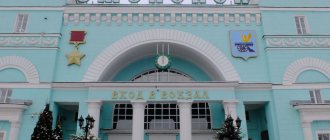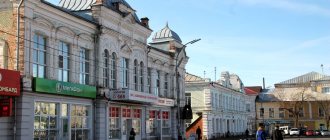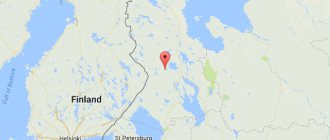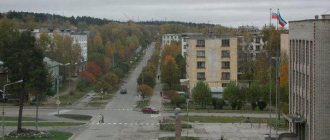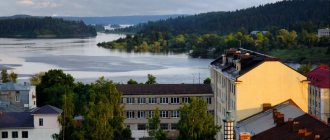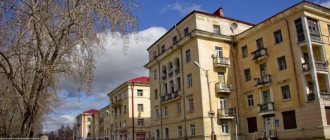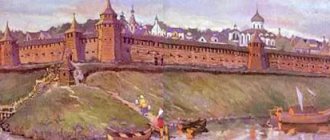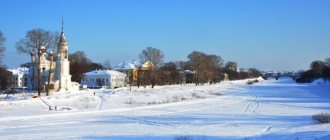Where is the city of Olonets located?
Olonets is a small city located in the north-west of the country in the Republic of Karelia. The settlement is located 166 km south of Petrozavodsk, and 186 km separates it from St. Petersburg. The population in the city is mixed, there are quite a few Russians here, mainly Karelians, Belarusians, Finns, Poles and others live in Olonets. In total, about 8 thousand people live in the city.
Despite the small size and small population of Olonets, the sights of the city are of great interest to tourists - historical and cultural.
general description
The city of Olonets is located near the confluence of the Mergega and Olonka rivers, this area is called the Olonets Plain. The national composition is dominated by Karelians - this is a feature of the city, they account for 58%, Russians come in second place - 37%. The population is declining, the maximum was recorded in 1992 - 12,100 people.
The climate is mild, the average annual temperature is 3.3 degrees Celsius. The warmest month is July, the coldest month is January. The weather in the city of Olonets is influenced by Lake Ladoga. The absolute minimum is -54 degrees, the maximum is +36 degrees Celsius. The average annual precipitation is 620 mm, and it is fairly evenly distributed over all 12 months. The greatest amount of precipitation usually falls in August - during this month the weather in these parts is often rainy. The least amount of precipitation in the Olonets region is recorded in February and March.
History of the city of Olonets
The first mention of the Karelian town dates back to the 12th century, and the main history of Olonets begins in the 17th century, from the time when the Olonets fortress was built on the banks of the Olonka River. In the next century, it performed important protective functions on the northwestern border of Russia, and only in the 18th century was it dismantled as unnecessary.
Until the middle of the 18th century, Olonets was of great commercial importance for Russia - not only Russian, but also European merchants did business here. Peter I himself often visited the city; the road to Martialnye Vody, a famous resort of that time, ran through Olonets.
After the city lost its strategic importance for Russia, its importance began to decrease. During the 19th century, no important events took place in the city, and in 1927 Olonets completely turned into a large village.
In the pre-war years, Olonets witnessed tragic events inside Russia; mass executions of repressed people and prisoners were carried out in its vicinity. With the outbreak of the war, the city fell under occupation and was liberated only in 1944, after which it received back the city status itself.
Interesting Facts
More than half of the population of Olonets and the entire region are Livvik Karelians. Many of them speak their native language, and the signs and some signs here are duplicated in Karelian.
The city's coat of arms, which appeared in 1730, is one of the oldest in the country. A hand with a shield emerging from the clouds symbolizes earthly and divine protection. Two crossed nipples are the city’s contribution to the creation of Russia’s naval power: logging, shipbuilding, casting guns and shells.
Every year at the beginning of winter, the Olonets Santa Claus Games are held here - a fun festival that brings together winter wizards from different regions and countries.
Sights of the city of Olonets
The Karelian town is of interest to tourists because it contains many attractions - historical sites and cultural monuments. A walk around Olonets allows you to learn a lot about the Republic of Karelia and all of Russia.
National Museum of Karelian-Livviks named after. N. G. Prilukina
The Museum of Local Lore is located in the very center of the city near the Slobodsky Bridge, in the historical merchant house of V.E. Kuttueva - the building itself is a landmark. The museum was opened in 1959 on the initiative of Prilukin, a famous ethnographer.
The basis of the museum's exposition is the sights of the culture and life of the Livvik Karelians, or Olonets Karelians. The exhibits include objects from the 19th and 20th centuries, textiles, as well as pagan amulets and shamanic staffs. In total, the exhibition includes about 20 thousand exhibits that are of great interest to ethnographers and historians.
On a tour of the national museum you can learn information about the traditions of the Livvik Karelians, their life and activities, culture, sights and origins. Among the halls of the museum there is a weaving art hall, where classes are constantly held; it is also a landmark of Olonets.
Olonets Art Gallery
There is an art gallery in the city of Olonets, opened in 1987. The territory of the museum covers 154 square meters. m of space and has 166 artistic paintings, most of them are by Karelian artists.
The gallery hosts creative meetings and conversations, joint classes of artists, as well as personal exhibitions of folk artists and artists recognized throughout Russia.
Cathedral of the Icon of the Mother of God of Smolensk
The Smolensk Cathedral, which stands on the inner island of Olonets in the city center and is surrounded by the Olonka and Megrega rivers, is the main architectural landmark of Olonets. The temple was built in the middle of the 18th century on the site of a small church and enjoyed great favor from Emperor Alexander I.
During the years of Soviet power, the Smolensk Cathedral was closed, and first there was a cinema within its walls, and then a museum. But at the end of the twentieth century, the building was again returned to the ownership of the Church, and currently the Smolensk Cathedral has been restored and is operational.
Assumption Church in the village of Kunilitsa
The snow-white church on the site of the former village of Kunilitsa dates back to 1788 and is one of the main attractions of the Olonets region and the central temple of Olonets. The cathedral was built by order of Catherine II, who often visited the Karelian town.
The history of the Assumption Church is unique in that even during the years of Soviet power the temple continued to operate continuously. Only in the 1960s was an attempt made to close the church and transfer it to the state, but this was actively opposed by parishioners. At the moment, services are still being held in the Assumption Cathedral.
Church of Frol and Laurus in the village of Megrega
The wooden church of Frol and Lavra, built in the 17th century, is a landmark that is a magnificent example of ancient Russian architecture. The temple is located in the village of Megrega, 11 km from Olonets, and services are still held there.
The main attraction of the church itself is its ancient three-tiered iconostasis, preserved from the 17th century. The location of the church in the landscape is very good - built on a low hill, it is surrounded by centuries-old pine trees and is almost invisible from afar.
Church in the village of Eroyla
In the village of Yeroila, not far from Olonets, there is another attraction - the white stone Church of the Savior Not Made by Hands. The church was built in the middle of the 18th century; it is crowned with 2 domes with hexagonal crosses - on the bell tower and above the entryway.
During the Soviet years, the church was closed and transferred to the needs of a rural club; during the 20th century it became noticeably dilapidated. However, over the past 15 years, the landmark has been seriously restored, and services are currently held in the church.
Church of the Holy Cross of the Church of Ingria
An interesting landmark of Olonets is a Protestant church, built quite recently. Although there are many European Protestant churches in Russia, they are usually located in large cities; they can rarely be seen in small settlements.
The Evangelical Lutheran parish in Olonets was founded only in 1996 with money from interested parishioners. Therefore, the church belongs to the category of modern attractions, but this does not make it any less interesting.
Vazheozersky Monastery
An important landmark of the Olonetsky district is the ancient Vazheozersky monastery, built on the shore of Lake Vazh in the 16th century.
Despite the fact that the monastery was founded in a very secluded forest corner, in the 17th century during the intervention it was discovered by the Poles and destroyed almost to the ground. Subsequently, the monastery was rebuilt, but in the twentieth century it was closed, like many other Orthodox monasteries. The monks of the monastery were sent into exile, a prisoner of war camp was opened within the walls of the monastery, and subsequently a psychiatric hospital. At the end of the twentieth century, the monastery was returned to the Church, and at the moment the monastery is again operating and receiving pilgrims.
Wooden suspension bridge in the village of Rypuskalitsa
In the village of Rypuskalice, not far from Olonets, on the road to Petrozavodsk, there is a small but very interesting attraction - a wooden pedestrian suspension bridge spanning the Olonka River.
The bridge consists of a wooden deck with railings, and two steel cables stretched between the pillars, which support the entire structure. If you walk across it, the bridge sways quite a lot.
Important! There are not many suspended wooden bridges in good condition left in Russia, so the landmark of the village of Rypuskalitsa will delight connoisseurs of unusual ancient structures.
Ancient wooden chapels
Near Olonets there are a huge number of ancient wooden churches and attractions that allow you to see the traditions of Russian architecture. Among the wooden chapels, several can be named.
- Chapel of Michael, Peter and Paul in the village of Novinka - built in the 18th century. cut from logs, a belfry with a tent roof rises above the rectangular building of the temple, the belfry pillars and roofing elements are decorated with decorative carvings.
- Chapel of St. George the Victorious in the village of Pertiselga - a wooden building was built in the 18th century; initially it was a small chapel, but in the 19th century a vestibule and a bell tower were added to it. The architectural plan of the attraction attracts attention; the chapel consists of two log houses of different heights; the wall of the chapel is triangular on the east. The entrance to the building is located so that it can only be seen from the forest.
- St. George Chapel in the village of Utozero - the building was built in the 19th century and was built entirely of wood. The small chapel is surrounded on all sides by pine forest and looks very picturesque. There is no altar in the building, so weddings, confessions, liturgies and communions are not held here, but believers from the village of Utozera and nearby settlements come to light candles and quietly pray in private.
It is also necessary to mention the Chapel of the Ascension of the Lord - the building of the 18th - 19th centuries is located in the village of Gavrilovka, not far from Olonets and is currently operational.
City Park
The park of the city of Olonets belongs to the category of attractions - it was founded about one and a half hundred years ago. There are many species of trees and shrubs growing in the park, some of which do not grow naturally in Karelia.
A fragment of an ancient pavement has also been preserved in the park. In the park you can visit a couple of historical buildings - the house of the merchant Kuttuev, which houses a museum, and the Catherine School, built in 1900.
Mass graves of Soviet soldiers
The city of Olonets has many attractions dating back to the period of the Great Patriotic War. In particular, there are several mass graves of Soviet soldiers located here:
- a mass grave of 19 military personnel at the monument to the “Unknown Soldier” who died in 1944 during the liberation of the Olonetsky region from German troops;
- a mass grave of 267 military personnel in the city cemetery, in which Soviet soldiers who died in the Olonets area in 1941 and 1944 are buried, as well as soldiers who died in a Finnish concentration camp on the territory of the city during the same period of the war.
Also on the street of the 30th anniversary of the Victory in Olonets there is a mass grave of 26 Red Guards and citizens of Olonets, shot by the White Finns in 1919.
Monument to Soviet military pilots
Another military landmark of Olonets is the monument to military pilots on Karl Marx Street. The monument is an airplane wing mounted on a concrete pedestal; the entire monument is painted silver.
At the top of the wing, the highest military award is depicted in gold - the star of the Hero of the Soviet Union. Below it is an inscription of gratitude to the pilots who died in the battles of the Great Patriotic War in the Karelian sky.
Monument to the heroes of the Olonets underground
On Svirskih Divisions Street in Olonets there is another military landmark, a monument to underground heroes. The monument was erected in 1975 on the site of a former concentration camp in which many Olonets underground fighters were executed. A memorial plaque made of white stone with a thank you inscription is attached to the landmark.
Monument to Soviet Soldiers-Liberators
Among the military sights of Olonets, it is necessary to note the obelisk in the form of a marble slab and an anti-tank gun, installed in 1974 on the site of a former prisoner of war camp.
The monument was erected to mark the 30th anniversary of the liberation of Karelia from the fascist invaders, and a memorial plaque on the monument informs that a message letter to future generations is walled up inside the obelisk. According to the plan, residents of Olonets should open this letter only in 2074.
Museum of Karelian-Livviks named after N.T.Prilukin
Address: Uritskogo st., 9 Phone: (81436) 2-13-31 Website: museum.ru/M1244 Opening hours: 10:00-17:00; Sunday: 11:00-15:00; Closed: Saturday Cost: adults: 30 rubles, schoolchildren: 20 rubles
An enthusiastic local historian, Prilukin devoted his entire life to collecting materials about the Livvik Karelians (Olonets Karelians). He managed to collect a large ethnographic collection of rare materials about the culture and life of this subethnic group, for example, items embroidered using the rare poimittu technique.
Based on the collection, the first local history museum in Karelia was opened in 1959. In addition to ethnography, there are other interesting exhibitions here, for example, an exhibition of old New Year's toys. There is a creative workshop teaching ancient Olonets weaving.
The museum occupies the house of the merchant Kuttuev, built in 1872 on the site of the chambers of the Olonetsky governor.
Holidays in Karelia in Olonets
A small Karelian town cannot offer tourists a huge amount of entertainment. However, there is already plenty to do here. People come to Olonets to enjoy the untouched nature and its beauty, learn more about the history and culture of their native land, and walk the streets of a calm provincial town. Fishing in Olonets is famous, since there are many lakes near the city.
You can stay in Olonets in mini-hotels and guest houses, as well as in cottages located in the city and in its environs. Holidays at the resort in Olonets are very comfortable, but at the same time the cost is quite affordable - in the Karelian town you can spend not only a pleasant, but also an economical vacation.
Assumption Church
Address: village Kunelitsy (territory of the city cemetery) Opening hours: 10:00-18:00
The temple was erected thanks to the efforts of Empress Catherine the First, who remembered the city where her husband often visited.
The only church that has always been active. This is the merit of the parishioners and especially Natalya Lobskaya, who in the sixties, during another wave of closures of existing churches, went to Moscow with a petition signed by city residents and defended the temple. Then she became a nun.
How to get to Olonets
Tourism in Olonets is also well developed because you can get to the Karelian city on your own in several ways. The most convenient way to travel to Olonets is from St. Petersburg - the following routes exist:
- by bus - from the bus station on the Obvodny Canal on a regular bus with a final stop in Petrozavodsk;
- by car - along the St. Petersburg-Murmansk highway, along the Kola highway or along the Blue Road to the Scandinavian direction;
- by train - by train from Ladozhsky station to Lodeynoye Pole, and from there by train to Pikyaranta or to Yanisjärvi with a stop at the station in Olonets.
You can also get to Olonets from Moscow. There are the following methods:
- by car - along the M10 highway the travel time will be approximately 11 hours;
- by train - from Leningradsky station you need to take a train in the direction of Murmansk or Petrozavodsk to Lodeynoye Pole, and from there cover the distance to Olonets by taxi or bus;
- by plane with a transfer to a bus - first you need to take a flight to Petrozavodsk, and then take ground transport to Olonets.
Advice! The last way to get to Olonets is the fastest, since the journey takes no more than 3 hours. However, an itinerary that includes air travel may be the most expensive.
Church of Frol and Laurus
Address: village Megrega How to get there: along the Petrozavodsk-Olonets highway. A visit must be arranged by calling the Smolensk Cathedral
A unique monument of wooden Novgorod architecture of the early 17th century. The church was built in memory of the war with the Lithuanians. Placed on a hill, it is visible from all sides: its head on an octagonal tent proudly rises among the trees. This is the oldest wooden building in Karelia.
After the victory over the Swedes, temples were erected throughout Rus' in memory of those killed. The Temple of Frol and Laurus was built on the way from Novgorod to the north. Travelers came here to pray for a safe end to their journey. Saints Frol and Laurus patronized agriculture, so the temple was also important for the surrounding peasants.
Inside there is a rarely seen tyablo iconostasis, giving an idea of what the decoration of Russian churches looked like before the 14th century. In the 19th century, the outside of the church was covered with stone. Services are held in the temple.
Photo of the city of Olonets in Karelia
To imagine the atmosphere of the Karelian city in advance, you can look at photos of Olonets sights with descriptions. Such pictures are presented in large numbers on the Internet, they are shared by tourists who have already visited the city.
Church of the Holy Cross Church of Ingria
Address: st. Svirskikh divisions, 12-a Telephone: (81436) 4-21-06 Website: https://cnacaem-uucyc.narod.ru/ Opening hours: 18:00-20:00 - constantly, during other hours according to the schedule of services and events.
A modern church, an example of a typical European Protestant church. This type of church is rare in Russia, especially in the provinces. It is especially interesting to see the differences in the architecture of Orthodox churches and Protestant churches.
